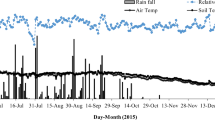Abstract
Split broadcast applications of prilled urea, deep point-placed urea supergranules (USG), and broadcast sulfur-coated urea (SCU) were compared as nitrogen sources for wetland rice (Oryza sativa L.) in two field experiments on a sandy soil (Typic Ustipsamment) with a high percolation rate (approx. 110 mm/day) in the Punjab, India. The USG was consistently less effective than the split urea and averaged 1 ton ha−1 less rice yield at the highest nitrogen rate (116 kg N ha−1). SCU produced the highest grain yields in both experiments; it averaged 1.7 ton ha−1 more than did the split urea at the highest N rate.
The fertilisers were then compared in field microplots; percolation was permitted or prevented so that the cause of the poor performance of USG could be elucidated. USG gave higher grain yield and N uptake in microplots that were not leached than in those that were leached. In leached microplots, the grain yields were higher from prilled urea than from USG treatments provided the placement pattern of the USG matched that of the field plots. Yields were not higher from treatments in which the USG were more closely spaced. In microplots in which leaching was prevented, the broadcast prilled urea was less effective than the deep-placed USG, which gave yields approximately 60% greater than those from split urea and the same as those from SCU. Broadcast prilled urea in undrained microplots caused high levels of ammonium (40 ppm) to develop in the floodwater where high pH (8.9) and high alkalinity (4.9 meq l−1) may have led to extensive ammonia volatilisation. The use of USG and SCU in undrained microplots reduced floodwater ammonium levels to less than 3 ppm.
Urea and ammonium leaching losses measured in fallow soil columns in the laboratory were much greater from USG than from prilled urea. Leaching losses from SCU were negligible. The data suggest that SCU is the preferred N source for rice soils having a high percolation rate and that USG is a poor alternative to split applications of prilled urea.
Similar content being viewed by others
References
Bremner JM and Edwards AP (1965) Determination and isotope ratio analysis of different forms of nitrogen in soil: I. Apparatus and procedure for distillation and determination of ammonium. Soil Sci Soc Amer Proc 29, 504–507
Craswell ET and Vlek PLG (1979) Greenhouse evaluation of nitrogen fertilisers for rice. Soil Sci Soc Amer J 43, 1184–1188
Craswell ET and Vlek PLG (1982) Nitrogen management for submerged rice soils. 12th Intern Congr Soil Sci 11, 158–181
Douglas LA and Bremner JM (1970) Extraction and colorimetric determinations of urea in soils. Soil Sci Soc Am Proc 34, 859–862
International Rice Research Institute (IRRI) (1979) Preliminary report on the first and second trial on nitrogen fertiliser efficiency in rice (1978/79), IRRI, Los Banos, Philippines
Jackson ML (1967) Soil chemical analysis. Prentice-Hall of India, Ltd., New Delhi, India
Mahli SS and Nyborg M (1979) Rate of hydrolysis as influenced by thiourea and pellet size. Plant Soil 51, 177–186
Vlek PLG, Byrnes BH and Craswell ET (1980) Effect of urea placement on leaching losses of nitrogen from flooded rice soils. Plant Soil 54, 441–449
Vlek, PLG and Craswell ET (1979) Effect of nitrogen source and management of ammonia volatilisation losses from flood rice soil systems. Soil Sci Soc Am J 43, 352–358
Vlek PLG and Stumpe JM (1978) Effects of solution chemistry and environmental conditions on ammonia volatilisation losses from aqueous systems. Soil Sci Soc Am J 42, 416–421
Walkley A and Black IA (1934) An examination of the Degtjareff method for determining soil organic matter, and a proposed modification of the chromic acid titration method. Soil Sci 37, 29–38
Author information
Authors and Affiliations
Rights and permissions
About this article
Cite this article
Katyal, J., Singh, B., Sharma, V. et al. Efficiency of some modified urea fertilisers for wetland rice grown on a permeable soil. Fertilizer Research 8, 137–146 (1985). https://doi.org/10.1007/BF01048897
Accepted:
Issue Date:
DOI: https://doi.org/10.1007/BF01048897




